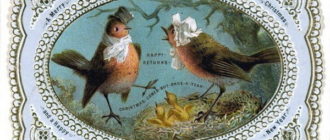
“The Lacemaker” – a painting created by Vasily Andreevich Tropinin in 1823, marked the beginning of a new direction in painting – genre portrait. The canvas depicts a young needlewoman. There is a lace-making machine in front of the girl, bobbins in her hands, and small scissors on the edge of the table. Soft light falls on the toiler’s face, emphasizing her lovely features. With a slight smile, she affably looks at the viewer, and her whole appearance, despite the simplicity of her dress and hairstyle, is full of grace and nobility. Tropinin not only reproduced the image of a needlewoman, he accurately and subtly captured one moment snatched from life. The girl does not pose for the artist. It seems that she was distracted from work only for a second, looked at the master with a smile and was about to return to lace again.
Brief description of the painting
Title of the painting: “The Lacemaker”.
Author: Vasily Andreevich Tropinin (1776-1857).
Year of writing: 1823
Size: 74.7 x 59.3 cm
Style: Realism.
Genre: Portrait.
Technique: Oil.
Material: Canvas.
Location: State Tretyakov Gallery, Moscow.

Vasily Tropinin is one of the most recognizable Russian masters of portrait painting of the 19th century. The artist, who worked first in a romantic and later in a realistic style, paid special attention to the characters of the heroes of his works. With deep sympathy and unfailing benevolence, he captured not only influential and famous contemporaries, but also images of ordinary peasants.
The Lacemaker was one of three paintings that the painter presented to the Council of the Imperial Academy of Arts in order to be eligible to be called the appointed artist. The portrait of a young needlewoman immediately attracted the attention of specialists and ordinary viewers with the novelty of the genre and plot, amazingly skillful execution. The center of the artist’s attention was not a noblewoman, but a lacemaker – a collective image of a Russian serf, painted with great art and love.
Painting “The Lacemaker” by Vasily Tropinin – a gentle image of a hardworking peasant woman
Tropinin managed to smooth out social differences, surprisingly reliably show the tenderness, kindness and charm of a simple girl. Graceful gestures, an attentive, slightly sly look, a sweet smile, attractive features – everything is depicted with captivating sincerity and genuine sympathy for the hardworking craftswoman. The artist paid no less attention to details. Carefully designed bobbins and pins, a thin lace ribbon, scissors – every little thing tells the story of painstaking work. Delicate silver-olive tones and warm shades create an atmosphere of tranquility and comfort. At first, the painting was in private collections. Then she got into the collection of the public Rumyantsev Museum in Moscow.
In 1924, the masterpiece was transferred to the State Tretyakov Gallery, where it can be seen today. The audience loved the picture so much that the author wrote seven copies. Some of them can be found in the Museum of Tropinin and Moscow Artists of his time in Moscow, in the collection of the Nizhny Novgorod State Art Museum and in the Saratov Art Museum named after Alexander Nikolaevich Radishchev.
The painting “The Lacemaker” by Vasily Andreyevich Tropinin is a wonderful scene from the past, in which simplicity, tenderness, kindness and sincerity are surprisingly combined. For 200 years now, she has made the viewer stop and smile in response to the friendly smile of a charming craftswoman.






